MEET
MIDI Harmonizer
Beef up your solo with randomized chords or
predefined chords on a per note basis
Original Rays
Here is a small sample of an improvised version of ‘Original Rays’, originally performed by Michael Brecker, now played by Eli Benacot using the MIDI Harmonizer V4.
Wind synth Harmonizer
Teacher, saxophonist and AKAI EWI player Lukasz Knapik is a great sound designer for electronic wind instruments. On his channel, the Art of Wind Synth, Lukasz is showcasing many audio clips and video clips with his EWI driving a large number of different hardware and plugin synths with very tasteful sounds indeed! In this video he is explaining and playing the MIDI Harmonizer using Xfer Serum plugin synths.
The MIDI Harmonizer
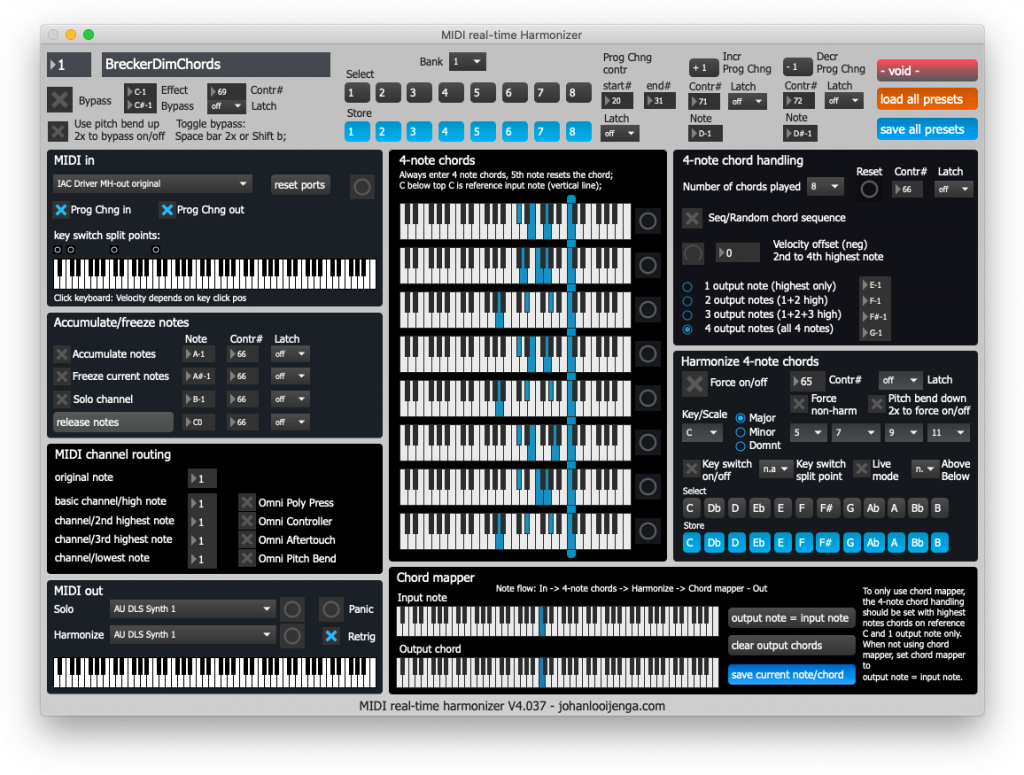
The MIDI Harmonizer is a standalone application that will take MIDI signals as input and will generate additional notes via MIDI as output. For each note played, the MIDI Harmonizer can generate random rotating chords, harmonize these chords towards specific musical keys and/or scales and can play fixed mapped chords on a per note basis. You can generate 4-note rotating chords as well as mapped chords with a maximum of 10 notes per chord per played note. This in total can generate up to 40 notes per played note if needed!
The MIDI harmonizer is a stand-alone application that runs on Mac (PC currently not supported). Under the hood, the MIDI harmonizer is based on the Max platform of Cycling74. Typically the MIDI harmonizer can be used both in the studio running on your favorite Digital Audio Workstation, as well as on stage running on a Mac. It can sit in between the MIDI signal coming from your instrument and the MIDI signal going to your DAW and/or synthesizer or plug-in instrument. Also it can be used as an insert MIDI application within many DAW’s including Pro Tools, Logic, MainStage or Live.
Chord Rotating & Chord Mapping
For each input MIDI note played, the MIDI harmonizer can rotate in sequence or randomly between up to 8 chords. These chords each have a basis of 4 notes per chord.
You can reset the sequence to start from the first chord at any moment by sending a MIDI cc message. You can decide to play all 4 chord notes or play less notes per chord. Each individual note in a chord can be send to a different MIDI channel driving a different sound. You can use a velocity offset for the second to 4th note in the chord to make the notes play softer compared to the main top note of the chord.
Each note of a 4-note chord can also be used as input for the chord mapper, multiplying the number of notes played with a maximum 10 notes per input note, making a total of 40 notes per input note played!
The chord mapper can also be used without using the 4-note chords. In this case you can program up to 10 notes for each specific input note.
By using the 4-note chord rotation, the chord mapper as well as the harmonizer, some really unexpected things can happen. You can either decide to use chord mapper only to be able to program exactly what is going to happen when playing a specific note, or you can mix 4-note chord rotation, harmonizer and chord mapper all together for unexpected effects, or anything in between!
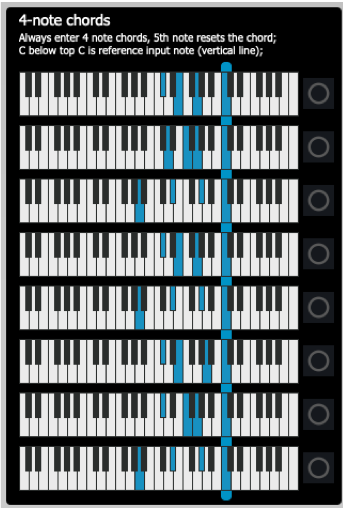
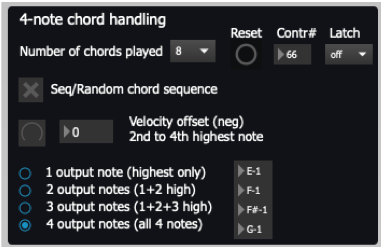

Harmonizer
You can harmonize the 4-note chords to force each note generated to fit into a specified key and scale. You can specify the key, scale as well as tensions 5th, 7th, 9th and 11th.
You can harmonize only notes belonging to the scale, so non-scale notes will then not be harmonized. You can also decide to harmonize all notes.
You can use key switching (specified lower notes) to change harmonizing to a specific key /scale on the fly while playing.
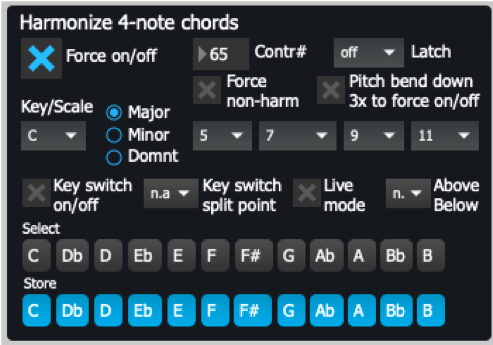
Accumulate notes & Freeze notes
With the MIDI Harmonizer you could play notes to build up a chord that keeps on growing. So you can accumulate notes into a complex and wide chord. You can then freeze that chord and then start soloing over the frozen chord. You can also freeze any chord played at any time, and then start soloing over the sustained chord. The chords are send out on a different MIDI port (and possibly multiple channels) then the solo sound (see MIDI in & MIDI out).
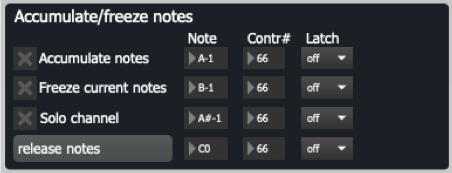
MIDI in & MIDI out
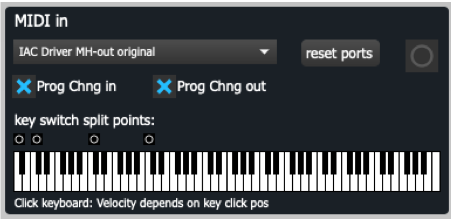
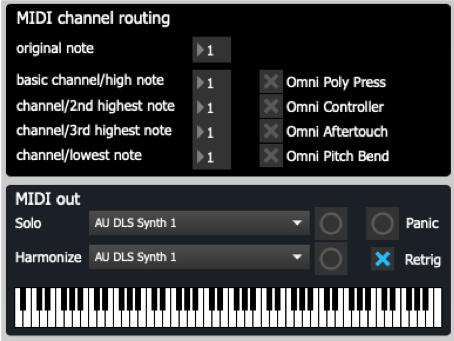
In the MIDI harmonizer you can select one input MIDI port and 2 MIDI output ports.
The input MIDI port can be used to connect to the output of your keyboard, your EWI or one particular output channel from your Digital Audio Workstation.
One output port is used for the (harmonized) chords (Harmonize port), while an additional output port is used for your solo sound (Solo port). The chords generated on the Harmonize port can be split up into 4 different MIDI channels. This allows you to generate 4 different sounds within your chords. On top of this the Solo port can drive yet another sound used for soloing on top of the sustained/frozen chords.
EWI Demo MIDI Harmonizer
Amsterdam-based sax and EWI player Itai Weissman tested out the MIDI Harmonizer. Besides the MIDI Harmonizer itself, the setup on the Mac includes Logic and the ES2 synthesizer. I did a couple of ES2 sounds for Itai to try out with the MIDI Harmonizer. Also I programmed the Logic Environment which is used to switch the MH effect on and off with a MIDI CC message coming from one of the switches on the EWI.
Eastern sounds with Eli Benacot
Obviously the MIDI Harmonizer was developed with Michael Brecker’s EWI usage of Oberheim Xpander sound patches with rotating oscillators in mind. Here is a recording from Eli Benacot from his album Hybrid Connections. You can hear the MIDI Harmonizer in action.
Brass arrangements with Aaron Todd
In this video Aaron Todd is demonstrating the MIDI Harmonizer. Each note of the chord that is generated by MH is routed to a different MIDI channel with a different horn sound on each channel. Aaron is also using the harmonizing function to force the notes into the right scales when playing and improvising. When the scale goes a half step up or down, Aaron is switching the harmonizer to a new scale to make sure the (rotating) notes all fit into the right scale. Nicely done!
Lush soundscapes with MIDI Harmonizer
You can use the MIDI Harmonizer to generate 4-note chords in a seamlessly random manner by playing a single note melody line. Most of the times you would program MH to just hang 3 notes underneath the top note, in many cases the top note being equal to the played (melody) note.
I got a nice example from ‘the lensman’ that created the following track using the MIDI Harmonizer together with Propellerhead Record/Reason:
Some McLaughlin fusion
In this video I play drums, synth and EWI including the MIDI Harmonizer. It’s a music piece called ‘Jazz’, a Mahavishnu Orchestra tune. Gear used: Akai EWI with Wallander Instruments WIVI band, Roland TD-4 drums with Toontrack EZdrummer 2, Moog Sub 37, and a bunch of UAD effects including Pultec EQ, DBX 160 drum compression, Lexicon 224 reverb, EMT 140 plate, multiband compression and limiting.
Inspiration
Quite some years ago I started developing a MIDI real-time harmonizer. I always wanted to experiment with generating additional and unexpected notes during live performance. Influenced by saxophonist and EWI player Michael Brecker, who started playing an Electronic Wind Instrument (EWI) driving rotating oscillators on a Oberheim Matrix synthesizer, I came up with a software version generating rotating chords. Since recent years I have expanded the idea further with the help of some very talented EWI players to include harmonization, chord mapping as well as accumulating and freezing chords.